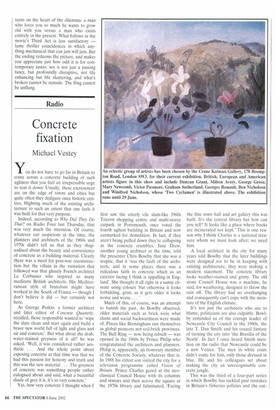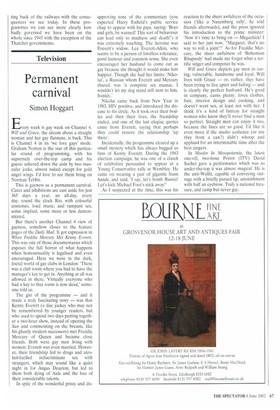Radio
Concrete fixation
Michael Vestey
Y
ou do not have to go far in Britain to come across a concrete building of such ugliness that you feel an irrepressible urge to tear it down. Usually, these excresences are on the edge of towns and cities but quite often they disfigure once historic centres, blighting much of the existing architecture to such an extent that one feels it was built for that very purpose.
Indeed, according to Why Did They Do That? on Radio Four last Thursday, that was very much the intention. Of course, whatever our suspicions at the time, the planners and architects of the 1960s and 1970s didn't tell us that as they rhapsodised about the beauty and convenience of concrete as a building material. Clearly there was a need for post-war reconstruction but the villain in the ruination that followed was that ghastly French architect Le Corbusier who inspired so many mediocre British architects. His Mediterranean style of brutalism might have worked in the South of France — though I don't believe it did — but certainly not here.
As George Perkin, a former architect and later editor of Concrete Quarterly, recalled, those responsible wanted to 'wipe the slate clean and start again and build a brave new world full of light and glass and air and concrete'. But what about the drab, water-stained greyness of it all? he was asked. 'Well, it was considered rather aesthetic . . . And the whole point about exposing concrete at that time was that we had this passion for honesty and truth and this was the new material. . . The greyness of concrete was something people rather eulogised about and said, what a beautiful shade of grey it is, it's so very concrete.'
Yes, how very concrete I thought when I first saw the utterly vile slum-like 1960s Tricorn shopping centre and multi-storey carpark in Portsmouth, once voted the fourth ugliest building in Britain and now earmarked for demolition. In fact, if they aren't being pulled down they're collapsing as the concrete crumbles. Jane Drew, another young architect at the time, told the presenter Chris Bowlby that she was a sceptic, that it 'was the fault of the architects, and in some places there was a ridiculous faith in concrete which as an exterior facing I think is appalling in England'. She thought it all right in a sunny climate using colours tut otherwise it looks forbidding, grim; as it gets older it looks worse and worse .
Much of this, of course, was an attempt to banish the past. As Bowlby observed, older materials such as brick were what slums and social backwardness were made of. Places like Birmingham saw themselves as global pioneers not red-brick provinces. The Bull Ring — now being rebuilt — was opened in the 1960s by Prince Philip who congratulated the architects and planners. Philip is, apparently, an honorary member of the Concrete Society, whatever that is. In 1988 his eldest son visited the city for a television programme called Vision of Britain. Prince Charles gazed at the neoclassical Council House with its columns and statues and then across the square at the 1970s library and fulminated, 'Facing the fine town hall and art gallery this was built. It's the central library but how can you tell? It looks like a place where books are incinerated not kept.' This is one reason why I think Charles is a national treasure whom we must look after; we need him.
A local architect in the city for many years told Bowlby that the later buildings were designed not to be in keeping with existing architecture, they were making a modern statement. The concrete library looks weather-stained and grimy. The old stone Council House was a machine, he said, for weathering, designed to throw the rain off. The library had no overhanging and consequently can't cope with the moisture of the English climate.
It's not just the architects who are to blame, politicians are also culpable. Bowlby reminded us of the corrupt leader of Newcastle City Council in the 1960s, the late T. Dan Smith and his crazed fantasy of turning the city into 'the Brasilia of the North'. In fact I once heard Smith mention on the radio that Newcastle could be a new Venice. The men in white coats didn't come for him, only those dressed in blue. He and his colleagues set about making the city an unrecognisable concrete jungle.
This was the third of a four-part series in which Bowlby has tackled past mistakes in Britain's fisheries policies and the cut ting back of the railways with the consequences we see today. In these programmes we can see more clearly how badly governed we have been on the whole since 1945 with the exception of the Thatcher governments.























































































 Previous page
Previous page